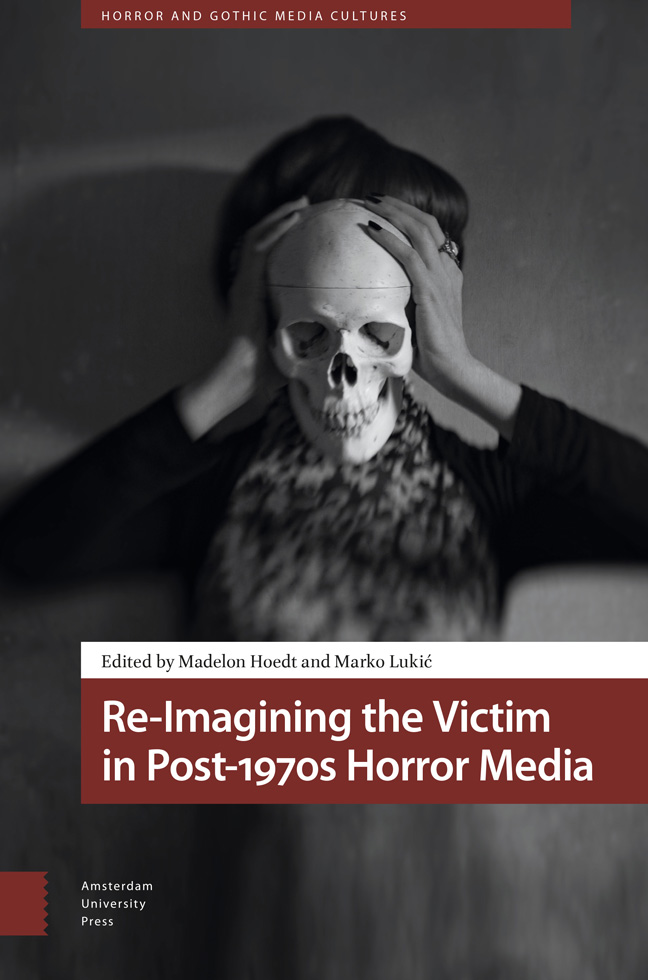Book contents
- Frontmatter
- Contents
- Introduction: Theorising the Victim
- 1 Opening the Gate: Reconfiguring the Child Victim in Stranger Things
- 2 Black Death: Black Victims in 1980s Teen Slashers
- 3 Beyond Binaries: The Position of the Transgender Victim in Horror Narratives
- 4 Through the Looking-Glass: The Gothic Victim in Jordan Peele’s Us
- 5 Postmortem Victimhood: Necrovalue in Phantasm and Dead and Buried
- 6 The Sad Killer: Perpetuating Spaces, Trauma and Violencewithin the Slasher Genre
- 7 “If this is the last thing you see… that means I died”: A Taxonomy of Camera-Operating Victims in Found Footage Horror Films
- 8 Victimhood and Rhetorical Dialectics within Clive Barker’s Faustian Fiction
- 9 Pain Index, Plain Suffering and Blood Measure: A Victimology of Driving Safety Films, 1955–1975
- 10 Biolithic Horror: Stone Victim/Victimisers in Resident Evil Village
- 11 The Potential Victim: Horror Role-Playing Games and the Cruelty of Things
- Bibliography
- Filmography
- Index
9 - Pain Index, Plain Suffering and Blood Measure: A Victimology of Driving Safety Films, 1955–1975
Published online by Cambridge University Press: 26 March 2024
- Frontmatter
- Contents
- Introduction: Theorising the Victim
- 1 Opening the Gate: Reconfiguring the Child Victim in Stranger Things
- 2 Black Death: Black Victims in 1980s Teen Slashers
- 3 Beyond Binaries: The Position of the Transgender Victim in Horror Narratives
- 4 Through the Looking-Glass: The Gothic Victim in Jordan Peele’s Us
- 5 Postmortem Victimhood: Necrovalue in Phantasm and Dead and Buried
- 6 The Sad Killer: Perpetuating Spaces, Trauma and Violencewithin the Slasher Genre
- 7 “If this is the last thing you see… that means I died”: A Taxonomy of Camera-Operating Victims in Found Footage Horror Films
- 8 Victimhood and Rhetorical Dialectics within Clive Barker’s Faustian Fiction
- 9 Pain Index, Plain Suffering and Blood Measure: A Victimology of Driving Safety Films, 1955–1975
- 10 Biolithic Horror: Stone Victim/Victimisers in Resident Evil Village
- 11 The Potential Victim: Horror Role-Playing Games and the Cruelty of Things
- Bibliography
- Filmography
- Index
Summary
Abstract
This essay examines the unique victims that populated early driving safety films in the United States. In these films, like Safety or Slaughter (1958), Signal 30 (1959), Red Asphalt (1960), Mechanized Death (1961), Wheels of Tragedy (1963), Highways of Agony (1969) and Death on the Highway (1971), the victims viewers see are people who experienced actual injuries, pain and death. In the collision-experiment films like Crash Research (1955), Crash and Live! (1955), Safety through Seat Belts (1959) and Safety Belt for Susie (1962), crash victims are most often stand-ins for the human body, crafted in plastic and metal: the crash test dummy and children’s dolls.
Keywords: automobility, car crashes, safety gore film, collision-experiment film, industrial films, crash victims
These are actual scenes taken immediately after the accidents occurred. Also unlike Hollywood, our actors are paid nothing. Most of the actors in these movies are bad actors and received top billing only on a tombstone. They paid a terrific price to be in these movies, they paid with their lives.
– narrator of Signal 30 (1959)You know the fallible factor in driving, don’t you? It’s you and me.
– narrator of Safety or Slaughter (1958)For the first seven decades of the automobile, every accident on the road was the driver’s fault. At least, this is how it was seen both in the eyes of the public and the dictates of the law. Once behind the wheel, the driver assumed a responsibility, in essence, for every other person in every other vehicle on the road. It also meant that every other person in an automobile was a potential victim, and whatever their grisly fate, the driver was to blame, meaning the act of driving was always charged with a moral imperative.
This all changed dramatically in 1965 with the publication of Ralph Nader’s best-selling book Unsafe at Any Speed, which revealed that it was actually the automobile itself that was most often responsible for crashes. Yet before Nader, the voice of authority on such matters largely stemmed from a group of driving education films that began appearing in the 1930s.
- Type
- Chapter
- Information
- Re-Imagining the Victim in Post-1970s Horror Media , pp. 171 - 190Publisher: Amsterdam University PressPrint publication year: 2024

